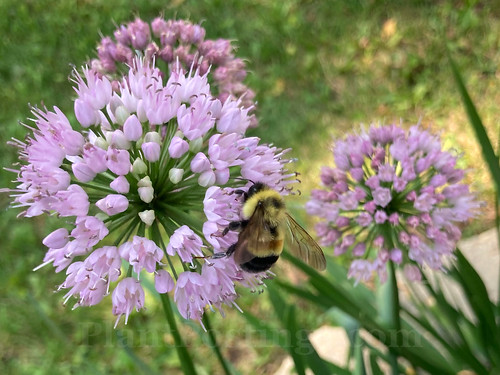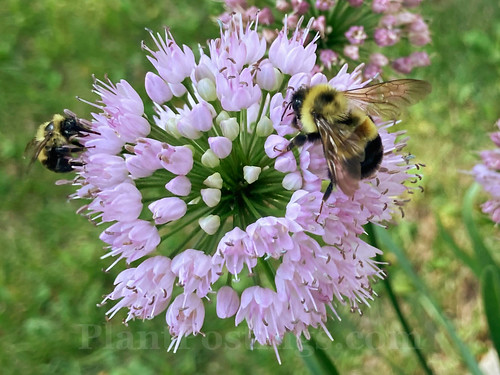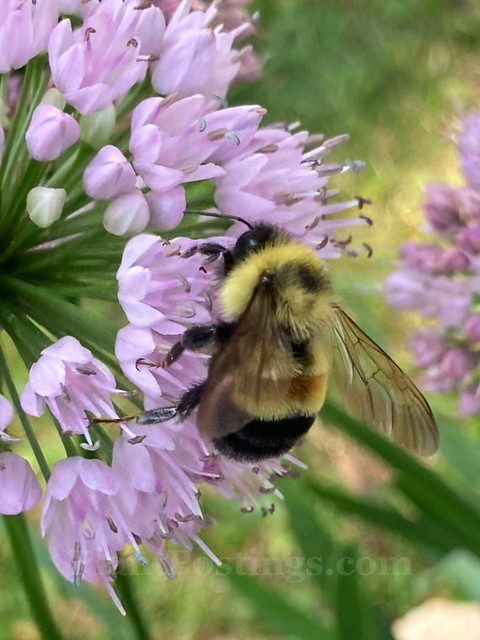


To learn more about the endangered rusty-patched bumble bee, visit xerces.org.
To report a sighting, visit bumblebeewatch.org.
Please avoid pesticides.



DEAR ANONYMOUS VISITORS: Please include your FIRST NAME. We need to know you're a real person. Security updates mean your comments likely will NOT be published unless you include your name. Sorry. Also, comments with hyperlinks might not make it through the heightened security system.
Other options: Click on the arrow next to "Anonymous" and choose either "Google Account" or "Name/URL"...
Your comment might not appear right away (even though we love you). PlantPostings uses comment moderation, and we read every comment before we publish.
Thanks for stopping by! Have a great gardening day!
Your wonderful photos suggest I should get out and check on my Alliums!
ReplyDeleteYes, you have a high chance of having RP bumble bees in your garden, too. They are definitely a presence at the Arboretum.
DeleteI have to look more closely at the bumblebees in my own garden to see if I can find any with that distinctive rusty patch. Thanks for sharing this, Beth!
ReplyDeleteYou may have some rare bumble bees in your garden, too, but the original range for the rusty-patched is Northeastern U.S. Fascinating creatures, all of them. :)
DeleteGood for you, Beth! so glad to hear an anti-pesticide message
ReplyDeleteThanks, Hollis. Too many pesticides all around us. There may be times when they are needed, but not for general use in a home garden.
DeletePesticides are horrible.
ReplyDeleteYes, agreed. Especially in a home garden setting.
DeleteVery nice photos. How special to see that bee! I like how bumblebees are calmer and don't mind being photographed. Some bees are very leery and difficult. Carpenter bees, I'm talking about you.
ReplyDeleteThank you, Lisa. Yes, the bumbles were preoccupied with the Alliums. So while they were moving, the were still just long enough for a few shots. ;-)
DeleteA good sign that we gardeners can be the CHANGE!
ReplyDeleteYes, we can make a difference. :)
DeleteBeautiful photos, Beth!
ReplyDeleteThank you, Susie. The blooms and the bumbles are special. :)
DeleteLovely creatures, and lovely that your garden helps support them.
ReplyDeleteHere perhaps because of our lavish rainy winter many many more bumbles than usual. I planted five plants of a newish Salvia--they must really get something from that kind--they appear to spend the day going through each flower and are also at the Myrtus communis and Zinnias. I'm thrilled there is something in the garden for them.
Best wishes and hope your drought is soon over.
They sure are fascinating to observe, aren't they? I'm amazed that these bumbles are doing so well despite the drought. Of course, I'm watering parts of the garden, but the Alliums are drought-tolerant. Thank you for your well wishes. We have precip in the forecast. Fingers crossed.
DeleteBeautiful blog
ReplyDeleteThank you. :)
DeleteThose bumbles and alliums make me smile. I'll bet you smile too! Great photos, Beth. Tina
ReplyDeleteThank you, Tina. Yes, the flowers and the bees bring out my smiles, too. :)
DeleteI’ve been meaning to take more pictures of pollinators in my garden, most photos end up a blur though. It’s interesting to see how many species of bumblebees that there are.
ReplyDeleteOh, agreed. I can't believe how many species of bees there are. I know this one because it's endangered and unique, but I have to look up most of them after I take a photo. They are amazing to observe, though.
DeleteBeautiful! I don't think I've ever seen one of those!
ReplyDeleteYes, they are beautiful, and I hope their numbers will recover so they won't be endangered anymore. The range for the RP is through most of the Midwest east to Maine, and south through the Appalachians.
DeleteBeautiful!
ReplyDelete